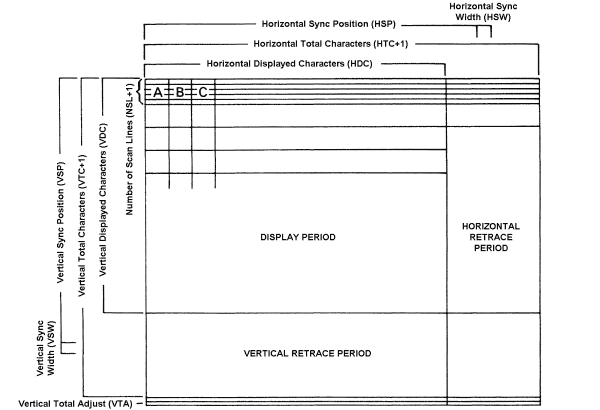CRTC
The 6845 CRTC (Cathode Ray Tube Controller) controls how the display is generated. It is written to with VDU 23,0 which also takes account of the current *TV and VDU 23,1 settings. The hardware is directly accessible at &FE00 and &FE01. The 6845 is used in the BBC, Master and System computers. Other display hardware is used on the Atom, Electron, and later computers
Most systems without a hardware 6845 CRTC implement setting the cursor state with registers 10 and 11 via VDU 23;10 and VDU 23;11.
Summary
|
&FE00 - Register number
Writing to &FE00 sets the register that will be accessed through the data register. The register number is a 5-bit number 0-31, but registers 18 to 30 are reserved. Register 31 is implemented on some 6845s (but what does it do?).
Some 6845s have a status register that is read at &FE00. This returns the following information:
- bit 7: always zero
- bit 6: set if there is a strobe input to the ~LPEN signal. It is cleared when either R16 or R17 (Light pen position) is read.
- bit 5: set during the vertical blanking period, when the VerticalCount >= VerticalDisplayed.
- other bits: usually zero, but often random
&FE01 - Register data
Using the data register reads or writes to CRTC registers. Registers are normally written to with VDU 23,0. the read/write registers have RAM copies in the VDU workspace which can be read with OSBYTE &A0.
Write-only registers return &00. Reserved registers (18 to 31) return &00.
Register 0 - Horizontal total (HTC)
This 8-bit register is the number of character bytes that represents the full horizontal line, covering the displayed and non-displayed area. The displayed characters this represents is a combination of the HTC and the colour depth set with the video ULA. MODEs 0 to 3 are 128 characters wide, with HTC=127, MODEs 4 to 7 are 64 characters wide, with HTC=63.
Register 1 - Horizontal displayed (HDC)
This 8-bit register is the number of displayed character bytes per display line. As with HTC, the number of visible characters is a combination of HDC and the colour depth set with the Video ULA. MODEs 0 to 3 are 80 characters wide, MODEs 4 to 7 are 40 characters wide.
Register 2 - Horizontal sync position (HSP)
Thsi 8-bit registers sets the position of the horizontal sync pulse measured in character bytes from the lefthand side. Increasing the HSP pushes the entire display to the left, decrementing it pushes the entire display to the right. The standard MODE 7 setting is 51, but 52 gives a more centred display.
Register 3 - Sync widths (HSW, VSW)
Register 4 - Vertical total
Register 5 - Vertical total adjust
Register 6 - Vertical displayed
Register 7 - Vertical sync position
Register 8 - Interlace/Display delay/Cursor delay
Register 9 - Scan lines per character
Register 10 - Cursor start line and blink type
Register 11 - Cursor end line
Register 12/13 - Screen start address
Register 14/15 - Cursor position
Register 16/17 - Light pen position
Register 18 - Cursor width
Register 19 -
Register 20 -
Register 31 - Register 31
MODE
Register | 0 | 1 | 2 | 3 | 4 | 5 | 6 | 7 |
--------------+---+---+---+---+---+---+---+---+
R0 HTC |127|127|127|127|127|127|127|127|
R1 HDC | 80| 80| 80| 80| 40| 40| 40| 40|
R2 HSP | 98| 98| 98| 98| 49| 49| 49| 51|
R3 HSW b3-b0 | 8| 8| 8| 8| 4| 4| 4| 4|
VSW b7-b4 | 2| 2| 2| 2| 2| 2| 2| 2|
R4 VTC | 38| 38| 38| 30| 38| 38| 30| 30|
R5 VTA | 0| 0| 0| 2| 0| 0| 2| 2| plus *TV setting
R6 VDC | 32| 32| 32| 25| 32| 32| 25| 25|
R7 VSP | 34| 34| 34| 27| 34| 34| 27| 27|
R8 INT b1-b0 | 1| 1| 1| 1| 1| 1| 1| 1| plus *TV setting
UND b3-b2 | | | | | | | | |
DIS b5-b4 | 0| 0| 0| 0| 0| 0| 0| 1|
CUR b7-b6 | 0| 0| 0| 0| 0| 0| 0| 2|
R9 NSL | 7| 7| 7| 9| 7| 7| 9| 18|
R10 b4-b0 | 7| 7| 7| 7| 7| 7| 7| 18|
b5 | 1| 1| 1| 1| 1| 1| 1| 1| changed for editing cursor
b6 | 1| 1| 1| 1| 1| 1| 1| 1| changed by VDU 23,1
R11 | 8| 8| 8| 9| 8| 9| 9| 19|
Extensions
Extensions to the VDU 23,0 interface, or extended hardware, should probably used register numbers 128 upwards.
Hardware differences
There are several slightly different versions of the 6845. The BBC series require a 6845S varient as the VDU drivers depend on certain functionality:
- R3 Vertical Sync.
- R6 Vertical Displayed any odd/even value, to set to 25 in MODE 3,6,7.
- R8 Character Delay and Cursor Delay timing for MODE 7.
Jgharston 14:47, 24 December 2007 (UTC) Jgharston (talk) 22:43, 15 January 2023 (CET) Jgharston (talk) 22:24, 16 January 2023 (CET)
